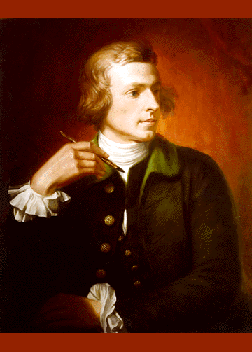
Charles Willson Peale (1741-1827)
Adrian Lamb (1901-1988), after the original portrait by Benjamin West,
circa 1768
Oil on canvas, 1975
30 x 25"
Maryland Commission on Artistic Property MSA SC 1545-1032
Charles Willson Peale, well-known American portraitist, was born in
Queen Anne's County, Maryland in 1741.
He arrived in Annapolis at the age of nine as an apprentice to a local
saddler. As a youth, Peale taught himself
to paint by observing the techniques of portraitist John Hesselius.
He also acquainted himself with the work
of John Singleton Copley on a visit to Boston, after which Peale won
the patronage of the Annapolis gentry.
A number of Peale's Annapolis patrons financed his 1767 trip to London
to study with renowned painter
Benjamin West. While learning from West in London, Peale completed
two full-length portraits of William Pitt,
one of which he presented to the new State House in Annapolis "as a
tribute of Gratitude." Returning to
America in 1769, Peale lived in Annapolis until 1775, and during those
six years, he traveled throughout
the Middle Colonies painting numerous portraits of colonial leaders.
In 1775, Peale moved to Philadelphia where, as an enthusiastic patriot,
he joined the city militia as a private.
A man "determined to do his utmost in the common cause of America,"
Peale took the rank of first lieutenant,
and accompanied his unit to the front in December of 1776. He
crossed the Delaware River from Trenton
into Pennsylvania just as the remnants of Washington's army arrived
on the river bank, and later described
their crossing as "the most hellish scene I have ever beheld."
Back in Philadelphia, Peale served on a number of revolutionary committees
as well as the
General Assembly of Pennsylvania. In 1802, he made a deliberate effort
to provide a pictorial record
of the Revolution for future generations. To this end, Peale established
a museum at Independence Hall
to display the portraits he had painted throughout the war.
Although Peale continued to paint, his later years were dominated by
a growing interest in natural history
and science. Ingenious exhibits of stuffed animals and birds
(as well as the reconstructed skeleton of a
mammouth that Peale himself unearthed) shared the spaces at Peale's
museum with his renderings of
American heroes and other notables.
A true "universal man" who plunged with equal enthusiasm into taxidermy,
"moving pictures,"
making false teeth and designing mechanical farm equipment, Charles
Willson Peale is best
remembered as the "Artist of the American Revolution." He was the patriarch
of what became an
extraordinary family of American painters which included his children
Raphaelle (1774-1825),
Rembrandt (1778-1860), Rubens (1784-1865), Titian Ramsay (1799-1885),
with niece
Sarah Miriam Peale (1800-1885), and nephew Charles Peale Polk (1767-1866).
The Maryland Commission on Artistic Property collection of state-owned
artwork includes
eleven portraits by Charles Willson Peale.
Among them are:
Washington, Lafayette and Tilghman at Yorktown
William Pitt
William Paca
and George Washington.
|
Tell Us What You Think About the Maryland State Archives Website!
|